Introduction
The Iranian Invasion of India occurred in the 6th century B.C. when King Darius I ruled over Iran. This invasion led to the occupation of territories in the North-Western Frontier Province, Sind, and Punjab in 516 B.C.
The Condition of India at the Time
North-east India gradually merged with the Magadhan Empire, but North-west India presented a different picture. Smaller principalities such as those of the Kambojas, Gandharas, and Madras fought against each other. The area lacked a powerful kingdom like Magadha to unify the warring communities into an organized kingdom. Moreover, it was fertile and rich in natural resources, making it vulnerable to its neighbors.
The Invasion
The Achaemenian rulers of Iran, who expanded their empire at the same time as the Magadhan princes, took advantage of the political disunity on the north-west frontier. The Iranian ruler Darius penetrated north-west India in 516 BC and annexed the Punjab, west of the Indus, and Sindh. This area was converted into the twentieth province or Satrapy of Iran, which had a total of twenty-eight satrapies. The Indian subjects were also enrolled in the Iranian army. Xerxes, Darius’s successor, employed Indians in the long war against the Greeks.
Conquest of Iranian Empire to India
The invasion did not affect Indian Politics in any significant manner, but it only exposed the weakness of the Indian defense in that region, paving the way for the conquest of Alexander. The Satrap system of administration introduced by Persians in Indian provinces served as a model to later dynasties, especially the Sakas and Kushanas.
Impact of the Invasion on India
- Political impact: Indians learnt the necessity of a strong and united empire to repel foreign invasions.
- Encouragement to trade: the mutual contacts helped in the growth of trade between the two countries.
- Settlement of foreigners on Indian soil: a large number of foreigners settled down in the North–Western parts of India and were completely absorbed among the Indians.
- Impact on art and architecture: Iranian art influenced Indian art. Ashoka followed the Iranian custom of preaching ideals by inscribing them on the stone pillars. The architecture of the period of Ashoka was influenced by Persian architecture.
- Interchange of Indo-Persian culture: Indian scholars and philosophers went to Persia and exchanged their views freely with the intellectuals of that country. This contact brought about a great change in the outlook of the people and brought them closer.
- Influence on Mauryan art: According to Megasthenes, the Mauryan ruler adopted certain Persian ceremonies and rituals, and the Mauryan art was influenced by Persian art to some extent. Iranian influence may also be traced in the preamble to Ashoka’s edicts as well as in certain terms used in them.
In 304 B.C.E., Seleucus I Nicator, the founder of the Seleucid dynasty and a former general of Alexander, launched an invasion of modern-day Punjab in northern India and Pakistan. However, Chandragupta managed to forge an alliance with Seleucus, which led to a period of cordial relations between the Seleucids and the Mauryan Empire. In fact, Seleucus even sent his ambassador, Megasthenes, to Chandragupta's court in Pataliputra (modern-day Patna in Bihar state) where he spent a considerable amount of time and wrote a detailed account of India and Chandragupta's rule. Diplomatic exchanges between the two empires continued until the eventual downfall of the Mauryan Empire.

